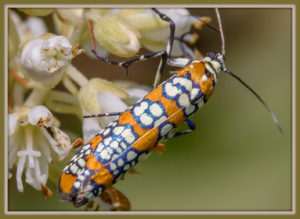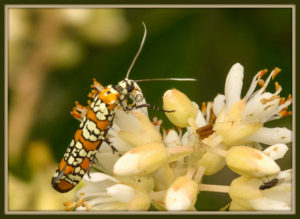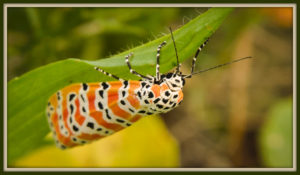Monday Multicolor Moths
Monday Multicolor Moths
March 13, 2017
Double-click on any image to view it full size. Click the back-button to return to your place on this page.
Greetings!
After featuring some rather drab butterflies last week, this week I offer two very colorful moths.
I must confess upfront that those of you who are long time subscribers might experience a sense of deja vu, because most of the text for this essay is “borrowed” from two old ones. However, all but one of the pictures are different from those I used just over two years ago.
Dorothea Lange said that “The camera is an instrument that teaches people how to see without a camera.”. (She said a bunch of other interesting things, some of which you can read at http://www.pbs.org/wnet/americanmasters/episodes/dorothea-lange/quotes-by-dorothea-lange/3159/ . Other sources use the word “tool” instead of “instrument”.) Since I got hooked on photography, I have certainly become aware of many wonders I would probably otherwise never have noticed, and had probably walked past many times before without seeing.
A case in point is the small (just over half-an-inch long) creature featured in this week’s pictures. Having seen it and captured a snapshot, I then demonstrated another of Dorothea’s quotes – “Photography takes an instant out of time, altering life by holding it still.” – because I was able to refer to that very mediocre image while searching the internet looking for an identification. Picture #1 is a newer and much clearer image, but would still have presented an identification challenge.

I looked through page after page of pictures of beetles, and saw many interesting pictures, but none matched my guy. Finally I stumbled upon the fact that it is not a beetle at all, but rather a member of the ermine moth family, specifically the Ailanthus Web-worm, Atteva aurea. Picture #2 gives an idea of how small this moth is when compared with the Tiger Swallowtail butterfly lurking on the other side of the same flower spike.

Of course, if that first picture had captured the coiled proboscis (see Picture #3), I would probably have realized that it was a moth, and saved a lot of time!

Since then I have seen them many times each summer, and I am still fascinated by their amazing markings, which are actually on the fore-wings that are normally wrapped along the body. But where did the common name come from? The insect itself is believed by scientists to have originally been a native of South Florida and the islands south to Costa Rica. Its larvae (caterpillars or “worms”) feed on The Paradise Tree (aka Bitterwood), Simarouba glauca, and the closely related Simarouba amara. Those trees do not tolerate frost, so they are not found north of Florida. However, in 1784 a species of tree was introduced to the United States from China (after having been introduced into Europe). It was known in some parts of China as the “Tree of Heaven”, and is only very distantly related to the Paradise Tree. (I have not been able to determine if the similarity of the names is coincidental or not.) (In other parts of China it was called “chouchun” 臭椿 , literally “foul-smelling tree” – quite a change from Tree of Heaven!) This tree belongs to the genus Ailanthus. That word certainly sounds Greek or Latin to me, but in fact is derived from the Ambonese word “ailanto”. Ambonese is the language of the natives of Ambon Island in Indonesia, and apparently “ailanto” translates as “Tree of the Gods” or “Tree of Heaven”! (One source provides another translation as “tree reaching for the sky”, which is probably linked to its rate of growth and height.) The species introduced to the US, Ailanthus altissima, is significantly hardier than the Paradise Tree, and so was able to spread across much of North America. It is however similar enough to the Paradise Tree that the moth (remember this essay is about a moth?) was able to use it as a host plant, and so the moth was also able to increase its range, and eventually acquired its common name because of the new host!
In both the US and Europe, Ailanthus altissima was initially found useful because it would thrive and grow rapidly in very poor or polluted soil where almost nothing else will. Indeed the title of the book “A Tree Grows In Brooklyn” is a reference to that ability! However, it spreads so easily and is so difficult to eradicate that it has become something of a nuisance. And its fruit can give-off an unpleasant odor (remember the alternative Chinese name?), and these properties have prompted some to dub it “Tree of Hell” instead of “Tree of Heaven”. In addition to hosting the larvae of the Ailanthus Web-worm moth, the tree is also a host plant for the imposing (almost 5” wingspan) Ailanthus Silkworm (Samia cynthia). That species is nocturnal and I have yet to see one, whereas Atteva aurea actively drinks nectar from flowers during the day.
I am glad to say that in spite of its name, the Ailanthus Webworm is NOT the caterpillar responsible for the unsightly and damaging “tents” we see on trees during the summer. The adult moth is a plant pollinator. Picture #4 shows no less than six of them (three on the center flower spike, two to the right, and one to the left), no doubt combining drinking nectar with pollinating.

Another rather touching fact I discovered while researching the original essay is that the female moth will return to her own cocoon to lay her eggs. The remains of the cocoon give the eggs some protection. I do not know if other species do this.
The final picture, #5, is not an Ailanthus Web-worm moth at all, but rather an Ornate Moth, Utetheisa ornatrix. It is not related to the Aianthus Web-Worm Moth (it belongs to the Tiger Moth family), but I include it because it is almost as small, and has somewhat similar coloring. Other common names for it are the Bella Moth, and the Rattlebox Moth – the latter because Rattlebox is one of the plants upon which its larvae feed.

Since each of these images (when viewed on a computer screen) will show the subject at more than life-size, they can loosely be defined as macro photos. However, rather than being taken with a macro lens, they were all taken with my trusty 28-300mm telephoto zoom lens, using the 300mm setting.Have a great week!